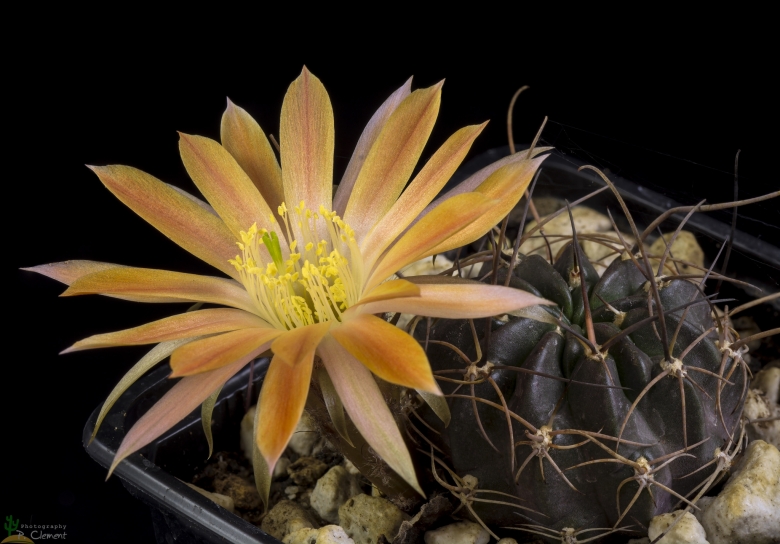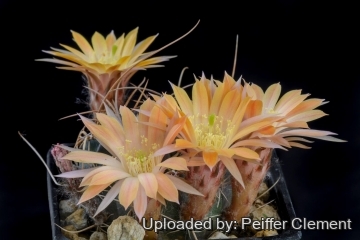= Echinopsis scheeri Salm-Dyck
Cact. Hort. Dyck. (1849) [ed. 1849] 179 (1849), 1850; Lab. I. c. 289; Rumpler in Handb. Cacteenk. [Forster]. ed. 2. f. 79, 80
Accepted Scientific Name: Echinopsis pentlandii (Hook.) Salm-Dyck ex A.Dietr.
Allg. Gartenzeitung (Otto & Dietrich) 14: 250. 1846 Otto & A.Dietr.

Lobivia scheeri (Echinopsis scheeri) Photo by: Peiffer Clement
Origin and Habitat: Arequipa,Peru.
Altitude range: 3600-4700 metres above sea level.
Synonyms:
See all synonyms of Echinopsis pentlandii
Description: Echinopsis scheeriSN|10595]]SN|10601]] (Lobivia scheeriSN|10600]]SN|10600]]), is a controversial cactus species generally included within (as a synonym of) {{SN'> 10595' alt='10595'>Echinopsis pentlandii#SN#10595'>{{[[Echinopsis pentlandiiSN' style='border:none;'>|SN|10595]]}}, suggesting that there is not really a fundamental difference between the two. The dark greyish-green or tan body with a long carrot like root, thin brownish or greyish spines, and long pale orange-red flowers helps distinguish this tree from other related species.
10595' alt='10595'>Echinopsis pentlandii#SN#10595'>{{[[Echinopsis pentlandiiSN' style='border:none;'>|SN|10595]]}}, suggesting that there is not really a fundamental difference between the two. The dark greyish-green or tan body with a long carrot like root, thin brownish or greyish spines, and long pale orange-red flowers helps distinguish this tree from other related species.
Stem: Single or forming shoots, ellipsoidal, 5-6(-10) cm thick dark greyish-green, dark blue-green or tan.
Ribs: 10-20 (or more), acute, separated by deep vertical grooves, crenate ( notched),obliquely interrupted at the areola.
Spines: Variable, all radial or sometime with one central.
Radial spines: 6, stronger and 4-5 thinner, acicular, slightly bent inward, about 26 mm long, at first dark purple and subsequently brownish or grey.
Central spines: 0-1, acicular to subulate somewhat recurved 3-9 cm long or less in young specimens.
Notes: Rumpler writes (1885): Sepaloid perianth segments elongated-linear, dark green, petaloid perianth segments numerous, pointed-lanceolate, lilac in the outside, light-cinnabar-red (or or also orange and yellow) with a darker mid-rib. W. Rausch 1992 (KuaS, 1992, H. 9, S. 9, S. 198-201): named Lobivia pampanaSN|34274]]SN|34274]] as Lobivia scheeriSN|10600]]SN|10600]] because this later name would be older.
For more details see: Echinopsis pentlandiiSN|10601]]SN|10595]]
More...Subspecies, varieties, forms and cultivars of plants belonging to the Echinopsis pentlandii group
 Echinopsis pentlandii (Hook.) Salm-Dyck ex A.Dietr.: Small quite variable species with long spins (up to 20 cm long in some clones). The flowers are of almost any colour: red, pink, yellow or bi coloured and have a very nice contrasting throat circle.
Echinopsis pentlandii (Hook.) Salm-Dyck ex A.Dietr.: Small quite variable species with long spins (up to 20 cm long in some clones). The flowers are of almost any colour: red, pink, yellow or bi coloured and have a very nice contrasting throat circle. Echinopsis pentlandii f. cristata hort.: Crested form, many clones available. Garden origin.
Echinopsis pentlandii f. cristata hort.: Crested form, many clones available. Garden origin. Echinopsis pentlandii subs. hardeniana (Boed.) G.Navarro: (Lobivia hardeniana) Older specimens produce very long spines (up to 20 cm long !!!) but younger specimens have short spines for years. Flowers multicoloured.
Echinopsis pentlandii subs. hardeniana (Boed.) G.Navarro: (Lobivia hardeniana) Older specimens produce very long spines (up to 20 cm long !!!) but younger specimens have short spines for years. Flowers multicoloured. Echinopsis pentlandii subs. larae (Cárdenas) G.Navarro: has dark purple, to pink lilac flowers with a paler throat. The stems are hemispherical and quite flattened with comb shaped radial spines. Distribution: Tarata to Rio Caine, Cochabamba.
Echinopsis pentlandii subs. larae (Cárdenas) G.Navarro: has dark purple, to pink lilac flowers with a paler throat. The stems are hemispherical and quite flattened with comb shaped radial spines. Distribution: Tarata to Rio Caine, Cochabamba. Echinopsis pentlandii f. variegata hort.: Colourful plants with green and yellow variegated parts.
Echinopsis pentlandii f. variegata hort.: Colourful plants with green and yellow variegated parts. Echinopsis pentlandii cv. Yellow (forma albinica) hort.: Chlorophyll-less Mutant with bright yellow stems. Garden origin.
Echinopsis pentlandii cv. Yellow (forma albinica) hort.: Chlorophyll-less Mutant with bright yellow stems. Garden origin. Echinopsis scheeri Salm-Dyck: has dark greyish-green or tan body with a long carrot like root, thin brownish or greyish spines, and long pale orange-red flowers. Distribution: Arequipa, Peru.
Echinopsis scheeri Salm-Dyck: has dark greyish-green or tan body with a long carrot like root, thin brownish or greyish spines, and long pale orange-red flowers. Distribution: Arequipa, Peru. Lobivia pentlandii f. aculeata (Buining) J.Ullmann: Plants covered by long stiff spines with bright purple-red flowers. Distribution: Tinquipaya, Potosi.
Lobivia pentlandii f. aculeata (Buining) J.Ullmann: Plants covered by long stiff spines with bright purple-red flowers. Distribution: Tinquipaya, Potosi. Lobivia pentlandii f. varians (Backeb.) J.Ullmann: (Lobivia varians) This form has orange flowers with a paler throat and extremely long spines (up to 25 cm long!). Distribution: Challapata to Potosí, Potosí.
Lobivia pentlandii f. varians (Backeb.) J.Ullmann: (Lobivia varians) This form has orange flowers with a paler throat and extremely long spines (up to 25 cm long!). Distribution: Challapata to Potosí, Potosí.
Bibliography: Major references and further lectures
1) Förster-Rümpler, “Die Cacteenkunde”. zweite Auflage. 1885.
2) Tim Inskipp, Harriet J. Gillett “Checklist of CITES species and annotated CITES appendices and reservations: a reference to the appendices to the Convention on International Trade in Endangered Species of Wild Fauna and Flora” CITES Secretariat, 2005
3) Lobivia pampana retrieved from Cactusinflo.nl on 09-07-2017 <http://cactusinfo.nl/index.php/64-cactus-en-vetplant-soorten/lobivia/119-lobivia-pampana>
4) Echinopsis scheeri Salm-Dyck, 1849 retrieved from cactuslove.ru on 09-07-2017 <http://www.cactuslove.ru/vid.php?vidid=2172>
 Lobivia scheeri (Echinopsis scheeri) Photo by: Peiffer Clement
Lobivia scheeri (Echinopsis scheeri) Photo by: Peiffer ClementSend a photo of this plant.The gallery now contains thousands of pictures, however it is possible to do even more. We are, of course, seeking photos of species not yet shown in the gallery but not only that, we are also looking for better pictures than those already present.
Read More...











